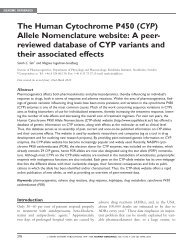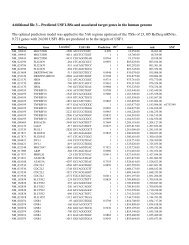REVIEW Laycock-van Spyk et al. neurofibroma, coupled with aberrant Remak bundles, could explain how the neurofibroma integrates into the surrounding tissue, and it is this that may lead to the surgical difficulties that often lead to tumour recurrence. Moreover, it has been suggested that surgical interference may even increase the recruitment of surrounding cell <strong>type</strong>s, thereby inadvertently increasing the growth of lesions leading to the formation of new neurofibromas. 84 Surgical biopsy is therefore inherently problematic, and novel therapeutics are urgently required. Clinical and preclinical trials targeting different components of the Ras/MAPK signalling pathway and related growth factor receptors appear to be more promising. It is likely, however, that treatment with multiple drugs may be more effective for NF1 <strong>tumours</strong>. 5 Concluding remarks Biallelic inactivation of the NF1 gene, resulting in the complete loss of functional neurofibromin, initiates the pathogenic process that eventually results in the formation of nerve sheath <strong>tumours</strong>. NF1 gene inactivation may occur through relatively subtle lesions that affect just a few DNA bases, or may involve large genomic changes that affect large chromosomal regions, or even the entire chromosome 17. This review demonstrates that NF1-<strong>associated</strong> tumour <strong>type</strong>s display a considerable degree of variation in terms of the level of LOH detected, with cutaneous neurofibromas, PNFs and MPNSTs. MPNSTs manifest increased levels of deletion-based LOH, whereas cutaneous neurofibromas appear to be <strong>associated</strong> with a localised deletion of the NF1 gene through mitotic recombination (the situation in PNFs being somewhat intermediate). In MPNSTs, additional mutations at different gene loci are almost certainly involved in the progression of the tumour. In terms of the molecular mechanisms of mutagenesis, both methylation-mediated deamination of 5-methylcytosine and slipped mispairing within polynucleotide tracts appear to be responsible for the occurrence of mutation hotspots in both the germline and the soma. For some <strong>type</strong>s of tumour, there is interplay between the soma and the germline, in that the location of the germline mutation can influence the nature, frequency and location of the subsequent somatic mutation. 85,86 As yet, however, there is no evidence for this phenomenon in the context of NF1 tumorigenesis. Although our knowledge of the role of the NF1 gene in tumorigenesis is ever expanding, definitive markers of malignant transformation remain to be discovered. Mouse and other animal models, including zebrafish, 87 have provided new perspectives for research, with various knockout and mutagenesis studies potentiating functional studies. It is already clear that, in order to clarify the role of the NF1 gene in NF1-<strong>associated</strong> <strong>tumours</strong>, we must improve our understanding of the significance of the somatic (second-hit) mutations. The brief assessment of the compilation of somatic NF1 mutations in NF1-<strong>associated</strong> tumour <strong>type</strong>s reported here failed to unearth any specific genotypic correlations. The limited size of the mutation dataset means that reliable conclusions are hard to draw, and that larger and better-defined patient groups will be needed, to allow more reliable comparisons to be made. Additionally, definitive prognostic markers should be identified that permit differentiation between benign neurofibromas that are likely to progress to malignancy and those that are not. This review nevertheless emphasises that NF1 is a highly individual condition that exhibits extreme somatic mutational heterogeneity both within and between patients. These are the mutations which are ultimately responsible for the molecular changes that can lead to tumour formation. If we can come to understand how these changes bring about tumorigenesis, we shall be better placed not only with respect to the provision of genetic counselling, but also in terms of exploring new avenues for the development of new drug-based therapies. Acknowledgments We are grateful to all our NF1 patients and their families for their support. We also thank Laura Thomas and Gill Spurlock for their help with the compilation of mutation data. 632 # HENRY STEWART PUBLICATIONS 1479–7364. HUMAN GENOMICS. VOL 5. NO 6. 623–690 OCTOBER 2011
<strong>Neurofibromatosis</strong> <strong>type</strong> 1-<strong>associated</strong> <strong>tumours</strong>: Their somatic mutational spectrum and pathogenesis REVIEW References 1. Huson, S., Harper, P. and Compston, D. (1988), ‘Von Recklinghausen neurofibromatosis. A clinical and population study in south-east Wales’, Brain Vol. 111, pp. 1355–1381. 2. Lammert, M., Friedman, J.M., Kluwe, L. and Mautner, V.F. (2005), ‘Prevalence of neurofibromatosis 1 in German children at elementary school enrollment’, Arch. Dermatol. Vol. 141, pp. 71–74. 3. Upadhyaya, M., Huson, S., Davies, M., Thomas, N. et al. (2007), ‘An absence of cutaneous neurofibromas <strong>associated</strong> with a 3-bp inframe deletion in exon 17 of the NF1 gene (c.2970-2972 delAAT): Evidence of a clinically significant NF1 geno<strong>type</strong>-pheno<strong>type</strong> correlation’, Am. J. Hum. Genet. Vol. 80, pp. 140–151. 4. Upadhyaya, M. (2011), ‘Genetic basis of tumorigenesis in NF1 malignant peripheral nerve sheath tumors’, Front. Biosci. Vol. 16, pp. 937–951. 5. Upadhyaya, M. (2010), ‘<strong>Neurofibromatosis</strong> <strong>type</strong> 1 (NF1): Diagnosis and recent advances’, Expert Opin. Med. Genet. Vol. 4, pp. 307–322. 6. Knudson, A. J. (1971), ‘Mutation and cancer: Statistical study of retinoblastoma’, Proc. Natl. Acad. Sci. USA Vol. 68, pp. 820–823. 7. Pao, W. and Girard, N. (2011), ‘New driver mutations in non-small-cell lung cancer’, Lancet Oncol. Vol. 12, pp. 175–180. 8. Sawada, S., Florell, S., Purandare, S., Ota, M. et al. (1996), ‘Identification of NF1 mutations in both alleles of a dermal neurofibroma’, Nat. Genet. Vol. 14, pp. 110–112. 9. Serra, E., Puig, S., Otero, D., Gaona, A. et al. (1997), ‘Confirmation of a double-hit model for the NF1 gene in benign neurofibromas’, Am. J. Hum. Genet. Vol. 61, pp. 512–519. 10. Parsons, D.W., Jones, S., Zhang, X., Lin, J.C. et al. (2008), ‘An integrated genomic analysis of human glioblastoma multiforme’, Science Vol. 321, pp. 1807–1812. 11. Ding, L., Getz, G., Wheeler, D., Mardis, E. et al. (2008), ‘Somatic mutations affect key pathways in lung adenocarcinoma’, Nature Vol. 455, pp. 1069–1075. 12. Sangha, N., Wu, R., Kuick, R., Powers, S. et al. (2008), ‘Neurofibromin 1 (NF1) defects are common in human ovarian serous carcinomas and co-occur with TP53 mutations’, Neoplasia Vol. 10, pp. 1362–1372. 13. Brennan, C., Momota, H., Hambardzumyan, D., Ozawa, T. et al. (2009), ‘Glioblastoma subclasses can be defined by activity among signal transduction pathways and <strong>associated</strong> genomic alterations’, PLoS One Vol. 4, p. e7752. 14. McGillicuddy, L.T., Fromm, J.A., Hollstein, P.E., Kubek, S. et al. (2009), ‘Proteasomal and genetic inactivation of the NF1 tumor suppressor in gliomagenesis’, Cancer Cell Vol. 16, pp. 44– 54. 15. Haferlach, C., Dicker, F., Kohlmann, A., Schindela, S. et al. (2010), ‘AML with CBFB-MYH11 rearrangement demonstrate RAS pathway alterations in 92% of all cases including a high frequency of NF1 deletions’, Leukemia Vol. 24, pp. 1065–1069. 16. Hölzel, M., Huang, S., Koster, J., Ora, I. et al. (2010), ‘NF1 is a tumor suppressor in neuroblastoma that determines retinoic acid response and disease outcome’, Cell Vol. 142, pp. 218–229. 17. Easton, D.F., Ponder, M.A., Huson, S.M. and Ponder, B.A. (2008), ‘An analysis of variation in expression of neurofibromatosis (NF) <strong>type</strong> 1 (NF1): Evidence for modifying genes’, Am. J. Hum. Genet. Vol 53, pp. 305–313. 18. Kehrer-Sawatzki, H. and Cooper, D.N. (2008), ‘Mosaicism in sporadic neurofibromatosis <strong>type</strong> 1: Variations on a theme common to other hereditary cancer syndromes?’, J. Med. Genet. Vol. 45, pp. 622–631. 19. Ballester, R., Marchuk, D., Boguski, M., Saulino, A. et al. (1990), ‘The NF1 locus encodes a protein functionally related to mammalian GAP and yeast IRA proteins’, Cell Vol. 63, pp. 851–859. 20. Upadhyaya, M., Kluwe, L., Spurlock, G., Monem, B. et al. (2008), ‘Germline and somatic NF1 gene mutation spectrum in NF1-<strong>associated</strong> malignant peripheral nerve sheath tumors (MPNSTs)’, Hum. Mutat. Vol. 29, pp. 74–82. 21. Andersen, L., Ballester, R., Marchuk, D., Chang, E. et al. (1993), ‘A conserved alternative splice in the von Recklinghausen neurofibromatosis (NF1) gene produces two neurofibromin isoforms, both of which have GTPase-activating protein activity’, Mol. Cell. Biol. Vol. 13, pp. 487–495. 22. Danglot, G., Régnier, V., Fauvet, D., Vassal, G. et al. (1995), ‘<strong>Neurofibromatosis</strong> 1 (NF1) mRNAs expressed in the central nervous system are differentially spliced in the 5’ part of the gene’, Hum. Mol. Genet. Vol. 4, pp. 915–920. 23. Kaufmann, D., Müller, R., Kenner, O., Leistner, W. et al. (2002), ‘The N-terminal splice product NF1-10a-2 of the NF1 gene codes for a transmembrane segment’, Biochem. Biophys. Res. Commun. Vol. 294, pp. 496–503. 24. Gutmann, D., Geist, R., Rose, K. and Wright, D. (1995), ‘Expression of two new protein isoforms of the neurofibromatosis <strong>type</strong> 1 gene product, neurofibromin, in muscle tissues’, Dev. Dyn. Vol. 202, pp. 302–311. 25. Upadhyaya, M. (2008), ‘NF1 gene structure and NF1 geno<strong>type</strong>/pheno<strong>type</strong> correlations’, In: Kaufmann, D. (ed.), Neurofibromatoses, Karger, Basel, pp. 46–62. 26. Bennett, E., Thomas, N. and Upadhyaya, M. (2009), ‘<strong>Neurofibromatosis</strong> <strong>type</strong> 1: Its association with the Ras/MAPK pathway syndromes’, J. Paediatr. Neurol. Vol. 7, pp. 105–115. 27. Cichowski, K., Shih, T., Schmitt, E., Santiago, S. et al. (1999), ‘Mouse models of tumor development in neurofibromatosis <strong>type</strong> 1’, Science Vol. 286, pp. 2172–2176. 28. Cichowski, K. and Jacks, T. (2001), ‘NF1 tumor suppressor gene function: Narrowing the GAP’, Cell Vol. 104, pp. 593–604. 29. Serra, E., Rosenbaum, T., Winner, U., Aledo, R. et al. (2000), ‘Schwann cells harbor the somatic NF1 mutation in neurofibromas: Evidence of two different Schwann cell subpopulations’, Hum. Mol. Genet. Vol. 9, pp. 3055–3064. 30. Le, L., Shipman, T., Burns, D. and Parada, L. (2009), ‘Cell of origin and microenvironment contribution for NF1-<strong>associated</strong> dermal neurofibromas’, Cell Stem Cell Vol. 4, pp. 453–463. 31. McLaughlin, M.E. and Jacks, T. (2003), ‘Progesterone receptor expression in neurofibromas’, Cancer Res. Vol. 63, pp. 752–755. 32. Dugoff, L. and Sujansky, E. (1996), ‘<strong>Neurofibromatosis</strong> <strong>type</strong> 1 and pregnancy’, Am. J. Med. Genet. Vol. 66, pp. 7–10. 33. Roth, T., Ramamurthy, P., Muir, D., Wallace, M. et al. (2008), ‘Influence of hormones and hormone metabolites on the growth of Schwann cells derived from embryonic stem cells and on tumor cell lines expressing variable levels of neurofibromin’, Dev. Dyn. Vol. 237, pp. 513–524. 34. Wu, J., Williams, J., Rizvi, T., Kordich, J. et al. (2008), ‘Plexiform and dermal neurofibromas and pigmentation are caused by Nf1 loss in desert hedgehog-expressing cells’, Cancer Cell Vol. 13, pp. 105–116. 35. Joseph, N., Mosher, J., Buchstaller, J., Snider, P. et al. (2008), ‘The loss of Nf1 transiently promotes self-renewal but not tumorigenesis by neural crest stem cells’, Cancer Cell Vol. 13, pp. 129–140. 36. Parrinello, S., Noon, L., Harrisingh, M., Digby, P. et al. (2008), ‘NF1 loss disrupts Schwann cell-axonal interactions: A novel role for semaphorin 4F’, Genes Dev. Vol. 22, pp. 3335–3348. 37. Zhu, Y., Ghosh, P., Charnay, P., Burns, D. et al. (2002), ‘Neurofibromas in NF1: Schwann cell origin and role of tumor environment’, Science Vol. 296, pp. 920–922. 38. Ingram, D., Yang, F., Travers, J., Wenning, M. et al. (2000), ‘Genetic and biochemical evidence that haploinsufficiency of the Nf1 tumor suppressor gene modulates melanocyte and mast cell fates in vivo’, J. Exp. Med. Vol. 191, pp. 181–188. 39. Yang, F.C., Ingram, D.A., Chen, S., Zhu, Y. et al. (2008), ‘Nf1-dependent tumors require a microenvironment containing Nf1þ/– and c-- kit-dependent bone marrow’, Cell Vol. 135, pp. 437–448. 40. Serra, E., Rosenbaum, T., Nadal, M., Winner, U. et al. (2001), ‘Mitotic recombination effects homozygosity for NF1 germline mutations in neurofibromas’, Nat. Genet. Vol. 28, pp. 294–296. 41. Thomas, L., Kluwe, L., Chuzhanova, N., Mautner, V. et al. (2010), ‘Analysis of NF1 somatic mutations in cutaneous neurofibromas from patients with high tumor burden’, Neurogenetics Vol. 11, pp. 391–400. 42. Garcia-Linares, C., Fernandez-Rodriguez, J., Terribas, E., Mercade, J. et al. (2011), ‘Dissecting loss of heterozygosity (LOH) in neurofibromatosis <strong>type</strong> 1-<strong>associated</strong> neurofibromas: Importance of copy neutral LOH’, Hum. Mutat. Vol. 32, pp. 78–90. # HENRY STEWART PUBLICATIONS 1479–7364. HUMAN GENOMICS. VOL 5. NO 6. 623–690 OCTOBER 2011 633





